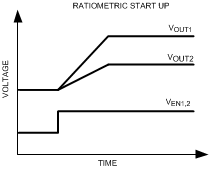SNVSB35C May 2018 – November 2024 LM26420-Q1
PRODUCTION DATA
- 1
- 1 Features
- 2 Applications
- 3 Description
- 4 Pin Configuration and Functions
- 5 Specifications
- 6 Detailed Description
-
7 Application and Implementation
- 7.1 Application Information
- 7.2 Typical Applications
- 7.3 Power Supply Recommendations
- 7.4 Layout
- 8 Device and Documentation Support
- 9 Revision History
- 10Mechanical, Packaging, and Orderable Information
Package Options
Mechanical Data (Package|Pins)
Thermal pad, mechanical data (Package|Pins)
Orderable Information
6.3.1 Soft Start
This function forces VOUT to increase at a controlled rate during start-up in a controlled fashion, which helps reduce inrush current and eliminate overshoot on VOUT. During soft start, reference voltage of the error amplifier ramps from 0 V to the nominal value of 0.8 V in approximately 600 µs. If the converter is turned on into a prebiased load, then the feedback begins ramping from the prebias voltage, but at the same rate as if started from 0 V. The two outputs start up ratiometrically if enabled at the same time, see the following figure.
 Figure 6-4 LM26420 Soft Start
Figure 6-4 LM26420 Soft Start